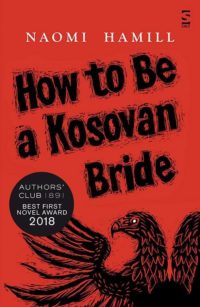They trusted that they might be okay. The war is over
 How to be a Kosovan Bride
How to be a Kosovan Bride
by Naomi Hamill
This book has a style that initially put me off and ended with me completely in love with it and the story. It was a random purchase in response to a social-media appeal from Salt Publishing. I love a good random find.
The language echoes that of folk tale, with most characters named for their role in the story rather than having a given name. It seems a little stilted at first, but as I got used to it I was able to admire the ways in which Hamill uses style to great effect. Words and phrases are repeated, drawing powerful parallels between characters and events.
“The confidence didn’t come at first. At first they were like spiders, scurrying from house to house…But when they could walk from house to charred house, only looking over their shoulders once to see if they were being followed, they began to feel better. When the schools started back and the hospital opened and UN tanks were seen only once in a while, then they trusted that they might be okay. The war is over, thank God…We are free. We will live. We will marry. We will move on.”
The two lead characters are the Kosovan Wife and the Returned Girl, their stories told alternately. They start out the same: after Kosovo gains independence and the country’s infrastructure begins to stabilise, two girls leave school a year early to get married. Their families and communities throw huge parties for their weddings. But when the traditional virginity test is conducted, one girl passes and stays with her husband, while the other girl fails and is sent home to her parents.
From this near-identical beginning, their lives have different paths, but there are similarities. The Kosovan Wife’s unhappy marriage and the Returned Girl’s continued education lead them to both write fiction of their own, and this starts to be interspersed with their stories. The Kosovan Wife is retelling an Albanian folk tale, while the Returned Girl is mining her family’s memories of the recent war. Through their fiction and their own lives, a picture is painted of Kosovo as a whole.
“Her husband likes his son. He wraps him in an Albanian flag and photographs him on his phone. One day he places a toy gun by his side and something in her wants to tear it away before the photograph can be taken. Of course, she laughs like everyone else and says ‘Yes, yes, he will be brave and a fighter’…Inside, she prays for peace for him. May he never have to hold a gun, she prays…Alone with her baby at night, feeding him, she whispers old Albanian folk tales as she rocks and soothes. But never those which talk of war. Instead, she whispers words of love deliberately into his ear: peace, she coos; kindness, she sings; gentleness, she murmurs; reconciliation, she prays.”
Chapter titles in the format “How to build a Kosovan house” and “How to have a Kosovan dream” hint at the pressure on people in Kosovo to get everything right, for the sake of their new country. But of course the focus on two young women isn’t accidental. Women must bear the brunt of the new country’s tightrope walk between honouring traditions – particularly those they had been denied as a suppressed population – and catching up with modernity.
The language is sparse but not without detail – emotional or otherwise. Are these characters representatives of types, or individuals? In the end, they’re both and that works far better than could be expected.
I was genuinely impressed by this book. I was moved, entertained and educated.
Published 2017 by Salt Publishing.
Source: Bought direct from the publisher.